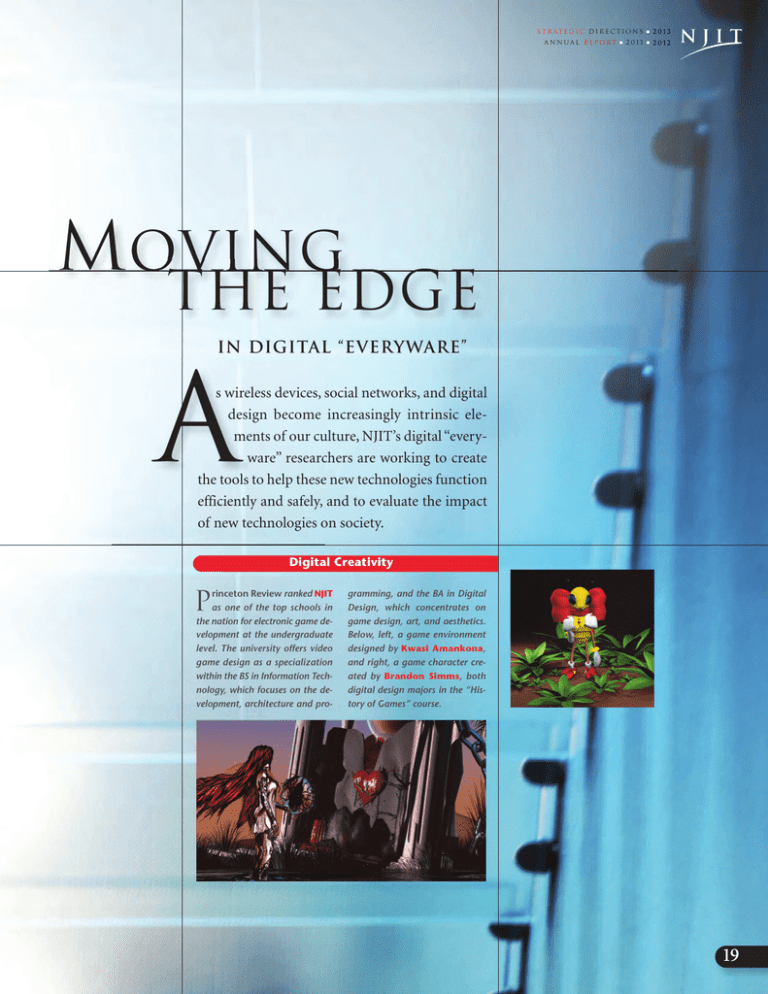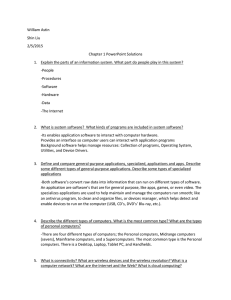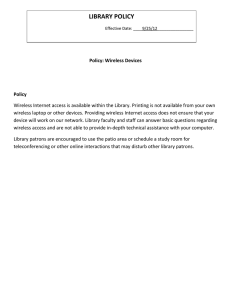A M OVING THE EDGE
advertisement

S t r at e g i c D i r e c t i o n s A N N UA L R E P ORT ■ 2011 ■ 2013 ■ 2012 M OVING THE EDGE IN DIGITAL “EVERYWARE” A s wireless devices, social networks, and digital design become increasingly intrinsic elements of our culture, NJIT’s digital “everyware” researchers are working to create the tools to help these new technologies function efficiently and safely, and to evaluate the impact of new technologies on society. Digital Creativity rinceton Review ranked NJIT as one of the top schools in the nation for electronic game development at the undergraduate level. The university offers video game design as a specialization within the BS in Information Technology, which focuses on the development, architecture and pro- P gramming, and the BA in Digital Design, which concentrates on game design, art, and aesthetics. Below, left, a game environment designed by Kwasi Amankona, and right, a game character created by Brandon Simms, both digital design majors in the “History of Games” course. 19 S t r at e g i c D i r e c t i o n s ■ 2 0 1 3 A N N UA L R E P ORT ■ 2 0 1 1 ■ 2 0 1 2 Digital Creativity recipient of the Provost’s Summer Research Award, Digital Design student Stephen Haddock-Weiler (below) investigated wayfinding in the digital environment. He tested and compared several methods used to navigate in virtual worlds including availability of minimaps, use of landmarks, and how the structure or layout of the environment can selectively reveal information and help the player navigate. Augustus Wendell, a university lecturer and coordinator of the Digital Design Program, served as his advisor. A OAD’s Physical Computing Lab is where digital everyware begins, encompassing concepts such as smart buildings and reactive spaces that can facilitate reduced energy consumption; intelligent products that recognize their users and adapt to their needs; interactive exhibits and inquiry-based learning. Physical computing blends digital design, information technology, industrial design and architecture, particularly in new C ssociate professor of humanities Christopher Funkhouser, (right), studies the emerging fields of digital literature, electronic media and hypermedia poetry, in which the functionalities of computing extend aesthetic possibilities in documents focusing attention on crafting verbal content. He recently published New Directions in Digital Poetry, volume 1 in the International Texts in Critical Media Aesthetics series in which he looks at the combinations of verbal, visual, animated and interactive elements that make up contemporary digital poetry and suggests methods for viewing works for audiences courses such as Computation Design and Interactive and Reactive Environments, created and taught by Assistant Professors Taro Narahara and Andrzej Zarzycki, respectively. In photo above right, architecture student Justin Carloni tests a project that uses sensors to create interactivity. Above, Digital Design students Kevin Cornelio, Thanh Nguyen, and Chris Narine use a portable motion-capture device to demonstrate interactive design for applicants at Winter Open House. A 20 esign and information technology students collaborated on interdisciplinary teams to create web and mobile video games for Global Game Jam. The School of Art + Design served as a host site – one of 242 around the world – for the second consecutive D unfamiliar with the mechanical and semiotics conventions being used. He also created a digital poem to commemorate President Joel Bloom’s inauguration. http://www.njit.edu/ inauguration/poem.php year. The intensive 48-hour event was coordinated by Assistant Professor Andrzej Zarzycki (Digital Design and Architecture) who was assisted and accompanied by other faculty including Lecturer Marc Sequeira (Information Technology), Adjunct Kunal Majmudar (Digital Design), Assistant Professor Taro Narahara (Digital Design), Lecturer Augustus Wendell (Digital Design), and Professor Glenn Goldman, director of the school. Above, a screen shot of Labyrinth, a game created by the team led by Digital Design student Ben Gross (left). S t r at e g i c D i r e c t i o n s A N N UA L R E P ORT ■ 2011 ■ 2013 ■ 2012 Toward Next-Generation Wireless Communications svaldo Simeone, (below, right) assistant professor of electrical engineering, is collaborating with InterDigital, Inc. and Distinguished Professor Schlomo Shamai of Technion University, to improve quality of service of wireless cellular systems based on cloud radio access technology, an enhancement of conventional cellular systems in which the baseband processing is migrated from the base stations to a remote unit in the “cloud” of processors within the O rofessor Alexander Haimovich (above) of electrical and computer engineering has been named to the Ying Wu Endowed Chair in Wireless Telecommunications, which is supported by a gift of $1.5 million from Ying Wu, ’88, founder of a highly-successful telecommunications firm. His research interests focus on advanced radar, sensing, and communication systems, including multiple-input multiple-output (MIMO) radar, geolocation, compressed-sensing for target localization, and signal design. Over the years, Haimovich’s research has been supported by the U.S. Army and Air Force, the National Science Foundation, and industry. P eheskel Bar-Ness, (above) distinguished professor of electrical and computer engineering, was honored recently at a ceremony which renamed the Center for Communications and Y operator network. Cloud radio access holds the promise of solving the problem of inter-cell interference in cellular systems, thus enabling high-data rate and highcoverage wireless transmission. ohn Federici, (below) distinguished professor of physics, researches various applications of Terahertz radiation, including wireless communications. The low terahertz (THz) frequency range has an inherently larger accessible bandwidth compared to microwave and millimeter communication bands. He is currently focusing on the reliability of terahertz wireless communications under outdoor atmospheric conditions. With a grant from the National Science Foundation, his goal is assessing the effects of atmospheric humidity, airborne particles such as rain, smoke or fog, and refractive index fluctuations (scintillations) on wireless terahertz communications links as compared with a free-space infrared link. race Guiling The goal is to promote the adoption and application of sensor networks through enhancing their survivability in the outdoor environment, providing better solutions for disaster rescue missions, military surveillance, and intelligent transportation systems. J Signal Processing in honor of his late son, Elisha Yegal Bar-Ness. Bar-Ness has directed the wireless communications center since its founding in 1986, leading its development into one of the world’s preeminent research organizations in the field. The center’s goal is to develop the infrastructure to enable the next generation of wireless telecommunications. The group addresses issues such as privacy and security, interference and jamming, ever-heavier user traffic, and rapid transmission of data through wireless networks. During FY2012, Bar-Ness’ team received nine new patents. Cell Phones, Sensors and Social Networks G Wang , (left) asso- esar Bandera, (left) assistant professor of management, focuses his research on the emerging field of mobile- or mhealth. Through his company Cell Podium, he has research support from the National Institutes of Health to develop applications for environmental public health outreach and training via cell phone. C In 2010-2011, he was enlisted by the Centers for Disease Control to help train clinicians in Haiti who were treating victims of a cholera epidemic. He also has grant support from the National Institute for Occupational Safety and Health to employ m-health technology to improve safety at construction sites. ciate professor of computer science, focuses her research on wireless sensor networks, vehicular networks, network security and mobile computing. She is leading an NSFfunded project to study network issues critical for building self-sustainable outdoor sensor networks. 21 S t r at e g i c D i r e c t i o n s ■ 2 0 1 3 A N N UA L R E P ORT ■ 2 0 1 1 ■ 2 0 1 2 Cell Phones, Sensors and Social Networks A ssociate Professor Cristian Borcea (left in photo at right) and computer science doctoral students Susan Pan (right in photo at right) and Mohammad Khan (not pictured) recently collaborated with researchers from the University of Versailles, France, in a study of strategies for re-routing vehicles to avoid traffic congestion. They developed a system that collects real-time traffic data from vehicles and road-side sensors and engchu Zhou, (above) professor of electrical and computer engineering, is leading a study that will use cell phone data to analyze the amount of social disruption caused by a disaster and how long it takes for the area to return to normal. The NSFfunded project will draw on the expertise of a civil engineer, sociologist, and a computer scientist using math, M computes proactive, individuallytailored re-routing guidance which is pushed to vehicles when signs of congestion are observed on their route. In a paper which appeared in the Proceedings of the 8th IEEE International Conference on Distributed Computing in Sensor Systems (DCOSS ’12), they presented and compared three rerouting strategies and found that all three offered a significant decrease in travel time. computer science and travel behavior research. The team will compare normal, everyday cell phone use with use during and after a disaster and will chart the process and speed by which usage returns to normal. The goal is to improve understanding of the effects of a disaster and to demonstrate how indirect measures can be used to study these events. Business Applications rofessor Ali Akansu (right in photo below) studies financial applications for high performance digital signal processing, particularly the potential use of improved realtime risk management practices and market efficiency through powerful analytical tools and execution. He served as lead guest editor of a special issue of IEEE Journal of Select- P ed Topics in Signal Processing on “Signal Processing Methods in Finance and Electronic Trading.” He and Mustafa Torun (left in photo below), doctoral student in electrical engineering, published a study of “Portfolio Risk in Multiple Frequencies” in IEEE Signal Processing Magazine. s Hurlburt Professor of Management of Information Systems in the School of Management. Associate Professor Katia Passerini (above) studies the implications of digital technologies on businesses and how technology in business affects the employees. She is co-author of information Technology for Small Businesses: A 22 Managing the Digital Enterprise with Karen Patten ’09, now with the University of South Carolina, and Ayman El Tarabishy of George Washington University. The book discusses how small and mediumsized businesses can leverage today’s mobile and “as-a-service” technology to thrive in highly competitive global environments. S t r at e g i c D i r e c t i o n s Keeping the Data Secure P rofessor Boris Verkhovsky (right) concentrates his research efforts on cryptography and security. He and doctoral student Roberto Rubino studied the problem of securing large corporate communications networks to develop techniques to prevent sensitive information from leaving the boundaries of the company network and falling into the hands of unauthorized users. They applied Gaussian cryptographic techniques and protocols to assist network administrators in the complex task of identifying the originators of data packets on a network and more easily policing their behavior. Their results were published in the International Journal of Communications, Network and System Sciences. un-Qing Shi , professor of electrical and computer engineering, shown above, right with doctoral student Haifeng Xiao ’12, researches multimedia data hiding, and a wide range of forensics and security-related issues, including robust water-marking, steganography and steganalysis, tampering detection, computer graphics classification from photographic images, camera identification, and detection of double JPEG/MPEG compression. In 201112, he gained seven new patents for inventions related to data hiding, watermarking and steganalysis. R A N N UA L R E P ORT ■ 2011 ■ 2013 ■ 2012 olette Santasieri and her Strategic Initiatives staff conducted a communication gap analysis of transportation sector port partners for the Area Maritime Security Committee and NJDOT. The purposes of the study were to determine: who communicates safety and security information at the Port (left) during an “incident;” problems experienced in communications; gaps in the communication chain; and measures to close such gaps. C Y erry Fjermestad, (left) professor of management, focuses his research in computer-mediated communications and leadership. He received a Bright Idea Decade Achievement Award sponsored by The New Jersey Policy Research Organization Foundation (NJPRO), indicating that he has won Bright Idea awards four times during the decade. The work for which he was cited deals primarily with virtual teams – how they communicate, and how team leaders delegate responsibility and authority. He also served as special editor of The Business Process Management Journal for an issue on IS evaluation and benchmarking for business performance improvement with Professors Stefan Smolnik and Nils Urbach of the EBS University of Business and Law in Wiesbaden, Germany. J eza Curtmola (right, stand- ing), assistant professor of computer science, focuses his research on the integrity of data stored remotely at a cloud storage provider, supported by an NSF CAREER grant. He and graduate student Bo Chen (right, seated) developed the first Robust Data Checking (RDC) schemes that provide robustness as well as supporting dynamic updates. Their work was published at the 35th IEEE Sarnoff Symposium and the 19th ACM Conference on Computer and Communications Security. In the Summer of 2012, Curtmola organized the Cloud Computing for Education Workshop at NJIT, a three-day professional development workshop for high school teachers, which focused on using cloud computing technologies to enhance the instructional process. 23




